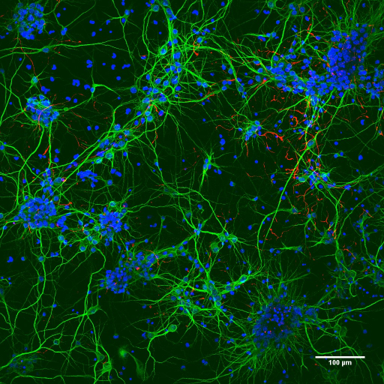Researchers create a hydrogel that allows cultivating neural cells to repair spinal cord injuries

The Materials Science Institute of Madrid (ICMM-CSIC) has developed hydrogels that allow cell culture under alternating high-frequency magnetic fields, an advance in the search for new therapies to cure spinal cord injuries. The work, published in the journal Acta Biomaterialia and funded by the European Union's Pathfinder program, will allow the incorporation of nanoparticles that carry nanomedicines to the damaged area to develop more precise therapies.
"The challenge is to develop a three-dimensional therapeutic matrix that is biocompatible and biomimetic with the spinal cord," explains Concepción Serrano, researcher at ICMM-CSIC and lead author of the study. The importance of achieving this matrix is the basis of their research project, which aims to cure spinal cord injury by inserting a biomaterial into the damaged area of the spinal cord that emits signals causing the healthy area to expand and colonize the gap caused by the damage. "No one has achieved this until now," Serrano mentions.
The researcher explains, "We cannot expect neurons to grow without a physical and chemical support that guides their growth. This implies that the biomaterial we develop must be mechanically compatible with the spinal cord, something that has received very little attention to date." To do this, they have explored collagen, a protein very abundant within the bodies of mammals and which also promotes the growth of blood vessels. "As part of the body, it will be biocompatible, biodegradable, and a good mechanical support, as well as a reservoir of molecules carrying repairing messages," adds Serrano.
The result has been a very soft foam and therefore compatible: "The spinal cord has an elasticity of about 600 pascals, and we have managed to make our foam only about 4 times stiffer. To put it into context, most of the biomaterials explored to date were of the order of 50 to 200 times stiffer, so we are much closer to success in this regard. In fact, we have observed that we are already in a range that the spinal cord tolerates without generating friction forces that generate unwanted scars."
The innovative aspect of this research goes further, as it explores this material for the treatment of spinal cord injury, makes it respond to the magnetic field, and also incorporates nanocarriers that will carry therapies (nanomedicines) where they are needed. "We have used iron oxide nanoparticles that, in addition, we have coated with natural polymers to make them even more biocompatible in interaction with cells," explains Serrano. The chosen polymers have been hyaluronic acid and chitosan, a derivative of chitin that also has bactericidal and neuroprotective properties, and whose production is "simple and cheap." In fact, the study has already concluded that this latter polymer seems more favorable for the culture of neural cells.
These hydrogels have already been implanted in an animal model of rats, so the next steps of this research involve analyzing whether they fulfill their purpose within the implanted organism and, at the same time, functionalizing the nanoparticles so that they act as carriers of nanomedicines. "We have managed to elaborate these magnetic matrices, characterize them well, and see what happens when we put them in contact with neuron cultures, which is what they will encounter when implanted," summarizes Serrano, who highlights that they have already been able to verify how "neurons grow without any problem and create highly interconnected networks."
Reference:
Julia Martínez-Ramírez, Marta Toldos-Torres, Esther Benayas, Natalia Villar-Gómez, Laura Fernández-Méndez, Francisco M. Espinosa, Ricardo García, Sabino Veintemillas-Verdaguer, María del Puerto Morales, María Concepción Serrano. Hybrid hydrogels support neural cell culture development under magnetic actuation at high frequency. Acta Biomaterialia. DOI: https://doi.org/10.1016/j.actbio.2024.01.030
Instituto de Ciencia de Materiales de Madrid (ICMM)
Sor Juana Ines de la Cruz, 3
Cantoblanco, 28049
Madrid, España
Telephone: (+34) 91 334 90 00
Email: @email
Communication Office: @email

Acknowledge the Severo Ochoa Centres of Excellence program through Grant CEX2024-001445-S/ financiado por MICIU/AEI / 10.13039/501100011033

Contacto | Accesibilidad | Aviso legal | Política de Cookies | Protección de datos